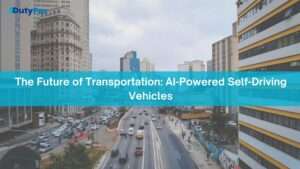 The transportation industry has always been a crucial part of our society, but it is currently undergoing a massive transformation due to the integration of artificial intelligence (AI) in the form of self-driving vehicles. The emergence of self-driving cars powered by AI has led to new possibilities, and the future of transportation is looking more exciting than ever before.
The transportation industry has always been a crucial part of our society, but it is currently undergoing a massive transformation due to the integration of artificial intelligence (AI) in the form of self-driving vehicles. The emergence of self-driving cars powered by AI has led to new possibilities, and the future of transportation is looking more exciting than ever before.
In this article, we will explore the potential of AI-powered self-driving vehicles and how they can revolutionize the transportation industry.
What are AI-powered self-driving vehicles?
Self-driving cars are vehicles equipped with sensors, cameras, and software that allow them to operate autonomously without human input.
The technology relies on AI, machine learning, and deep learning algorithms to help the vehicle navigate, make decisions, and respond to the environment.
The development of self-driving cars is still ongoing, and it is expected that the technology will continue to evolve to become more advanced and efficient.
One of the most significant advantages of AI-powered self-driving vehicles is that they can help reduce accidents caused by human error, which is a significant cause of traffic fatalities.
Benefits of AI-powered self-driving vehicles
Increased Safety
One of the most significant benefits of AI-powered self-driving vehicles is increased safety.
Human error causes a significant number of accidents on the roads, and self-driving vehicles can help reduce this by eliminating the need for human input.
Self-driving cars are equipped with advanced sensors and cameras that can detect obstacles and respond to them in real-time, significantly reducing the risk of accidents.
Improved Traffic Flow
Self-driving cars can communicate with each other and share information about traffic, road conditions, and other relevant data.
This communication can help improve traffic flow and reduce congestion on the roads, leading to faster and more efficient travel times.
Reduced Emissions
AI-powered self-driving vehicles can help reduce emissions by optimizing driving patterns and reducing fuel consumption.
The vehicles can also operate more efficiently by avoiding traffic and choosing the most efficient routes, further reducing emissions.
Increased Accessibility
Self-driving cars can help improve accessibility for people with disabilities, the elderly, and those who do not have access to transportation.
The vehicles can operate autonomously, eliminating the need for a driver and making it easier for people to get around.
Challenges of AI-powered self-driving vehicles
While AI-powered self-driving vehicles have significant potential, there are still some challenges that need to be addressed before the technology can be fully integrated into society.
Technical Issues
The technology behind self-driving cars is still relatively new and is continually evolving.
There are still some technical issues that need to be addressed, such as how the vehicles can operate in extreme weather conditions and how to ensure the safety of passengers in the event of a system failure.
Legal and regulatory issues
There are also legal and regulatory issues that need to be addressed before self-driving cars can become widespread. For example, who is responsible if an accident occurs—the manufacturer, the owner of the vehicle, or the software developer?
Cost
The cost of AI-powered self-driving vehicles is currently high, making it difficult for the technology to be accessible to everyone.
The technology needs to become more affordable to make it accessible to a broader range of people.
The Future of AI-Powered Self-Driving Vehicles
Despite the challenges, the future of transportation looks bright with the emergence of AI-powered self-driving vehicles.
The technology has the potential to revolutionize the transportation industry by improving safety, reducing emissions, improving traffic flow, and increasing accessibility.
As the technology behind self-driving cars continues to evolve, we can expect to see more widespread adoption of the technology.
Self-driving cars are already being tested on public roads in some countries, and it is only a matter of time before they become more common.
Some experts predict that in the future, self-driving cars will become the norm and traditional cars will become a thing of the past.
This shift could lead to significant changes in the transportation industry, such as a decrease in car ownership and an increase in ride-sharing services.
Additionally, the integration of AI in the transportation industry goes beyond self-driving cars.
AI can be used to optimize traffic signals, improve public transportation, and even develop more efficient urban planning.
Conclusion
The future of transportation is looking more exciting than ever before, thanks to the emergence of AI-powered self-driving vehicles. While there are still challenges that need to be addressed before the technology can become widespread, the benefits of the technology are undeniable.
Increased safety, improved traffic flow, reduced emissions, and increased accessibility is just a few of the potential benefits of self-driving cars.
As the technology continues to evolve, we can expect to see more widespread adoption of self-driving cars, leading to significant changes in the transportation industry.
While it may take some time for the technology to become fully integrated into society, the future of transportation looks bright, and AI-powered self-driving vehicles will undoubtedly play a significant role in shaping that future.

